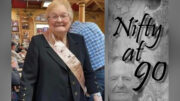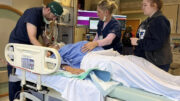Today marks the 75-year anniversary of the surprise attack by the Japanese on Pearl Harbor, and that day of “infamy” turned the U.S. into a nation at war.
On Dec. 7, 1941, there were 32 men from Venango, Clarion and Forest counties stationed with the U.S. armed forces in Hawaii, either at Pearl Harbor or nearby.
The Derrick published extensive retrospectives about the attack for both the 25-year anniversary in 1966 and the 50-year anniversary in 1991. Interviews were conducted with many of the men who were at Pearl Harbor, and they vividly recalled the horror of that day.
A look through the newspaper’s archives dating back to the mid-1990s shows that many of those men have since died, but the legacy of their service will always live on.
Here is a list of some of the men from the tri-county area who were at Pearl Harbor or elsewhere in Hawaii on Dec. 7, 1941. The information includes their hometowns and has been gleaned from newspaper archives and from interviews conducted by the newspaper in 1966 or 1991.
— Rennie Schneider, of Oil City, was at Pearl Harbor in a radar unit known as the 581st Aircraft Warning Signal Corps.
— E. Craig Elliot, of Sligo, was at Pearl Harbor as part of the same Aircraft Warning unit as Schneider.
— John T. Sherick, of Oil City, was also at Pearl Harbor in the same Aircraft Warning unit as Schneider and Elliot.
— Stephen Rekiel, of Oil City, was at Pearl Harbor as part of the 35th Infantry.
— Joseph A. Makowski, of Oil City, was at Pearl Harbor with the U.S. Marine Corps.
— Francis “Gabby” Gabreski, of Oil City, was at nearby Wheeler Field, which was the primary target and site of the first attack on Dec. 7, 1941, that led up to the attack on Pearl Harbor.
— Bruce Christenson, of Oil City, was a musician stationed in Oahu with the 16th Coast Artillery Band.
— Loren Guth, of Oil City, was at Oahu with the 19th Infantry, 24th Division.
— Park J. Reed, who lived in both Oil City and Franklin, was at Wheeler Field.
— Thomas Liotta, of Franklin RD 1, was with the 11th Bomb Group at Hickam Field during the attack.
— Donald Harry Nelson, of Huey, was at Pearl Harbor. He had been at Honolulu on a three-day pass before returning to the barracks on Dec. 7.
— Robert E. Smith, of Clarion RD 2, was stationed at Wheeler Field.
— James Stewart, of Sligo, was a member of the 482nd Ammunition Company and was at Hickam Field during the attack.
After the attack
One day after the bombing, lives changed dramatically in the region and across the nation as the country entered World War II.
Defense guards were posted at bridges, water tanks, and other structures in the tri-county area.
Young men left by the dozens each day to enlist in the service, and familiar area landmarks from cannons to railroad tracks were dismantled and donated as scrap metal.
Headlines in The Derrick on Dec. 8, 1941, said “Japs Begin War on U.S.” Inside, the newspaper called for unity.
The nation would not know for another week that the true number of Americans killed at Pearl Harbor exceeded 2,000.
Early on Dec. 8, a long line of men waited outside the Oil City post office. The recruiting office signed up 43 enlistees the first day and 29 more the next day.
The first area man to enlist after the declaration of war was Alfred L. Carll of Newmansville, who joined the Army Air Corps shortly after 8 a.m. Dec. 8. A local minister and a nurse received call-ups to active duty later in the week.
Area manufacturing plants immediately beefed up their security and practiced black-out drills.
And the first air raid alarm in the history of Oil City sounded Dec. 16, 1941, at Lincoln Junior High School. The trial alarm consisted of nine claps and sent students scurrying to huddle in the corridors.
By the end of the war, The Derrick listed at one time or another information on the thousands of local residents serving in the armed forces.
And the newspaper printed stories on the combat deaths of nearly 100 Venango County residents. Another 200 county soldiers and sailors lost their lives in accidents or to illness at both stateside and foreign military bases during the war.







































